An Acoustic Camera is making pictures of sound fields. Therefore an array of many microphone is needed which record the sound simultaneously. At the Institute of Systematic Musicology a microphone-arry consisting of 128 mics is used. These are put in front of musical instruments like with a guitar:
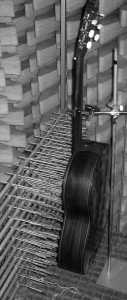
or a piano:
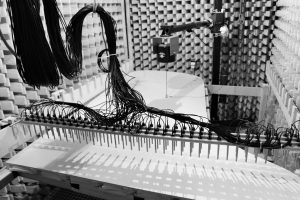
This results in 128 recordings or a musical note at different positions in space. From these single frequencies are taken, calculating their amplitude and phase at all microphone positions. If these are known, using mathematical methods of back-proagation, the sound-field right at the surface of the instruments is calculated. Then the vibrating modes of instruments can be seen like here with a drum:
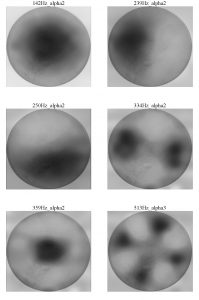
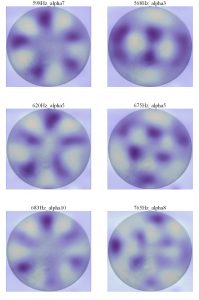
or with a vihuela, a Spanish Renaissance guitar (left) or a piano soundboard (see piano for more details).
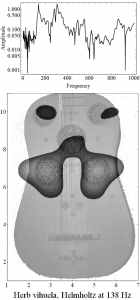
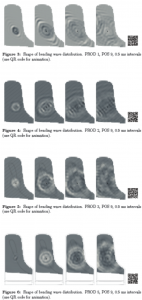
The method used at the Institute of Systematic Musicology, University of Hamburg is the Minimum Energy Method (MEM). It assumes that there are as many sound radiating points on the musical instrument surface as there are recording microphones. Below the mics are on the left, the radiating points on the right:
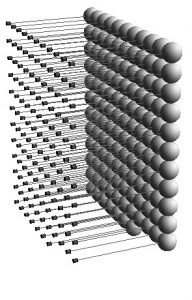
Then the radiation points are assumed to have a certain directivity towards the microphones. In the picture above they are all monopoles radiating to all directions with the same strength. On the other extreme each radiating point might have a sharp directivity only radiating to the microphone opposite to it. All directivities in between are also possible.
Still we do not know the directivity, still theory holds, that there each assumed directivity leads to a reconstruction of the soundfield near the instrument. Each of these recontructions has stronger or weaker amplitudes. The correct directivity is that where the back-propagated soundfield has a minimum of energy. Therefore this method is called the Minimum Energy Method (MEM).
Still of course there are many other methods of back-propagation and many other possibilities to use a microphone array.
Lit.:
Bader, R.: Microphone Array. In: T. Rossing (ed.): Springer Handbook of Acoustics 1179-1207, 2014.
Bader, R., Münster, M., Richter, J, & Timm, H.: Microphone Array Measurements of Drums and Flutes. In: Bader, R. (ed. / Hrsg.).: Musical Acoustics, Neurocognition and Psychology of Music / Musikalische Akustik, Neurokognition und Musikpsychologie. Hamburger Jahrbuch für Musikwissenschaft 25, 13-54, 2009.
Bader, R.: Characterizing Classical Guitars Using Top Plate Radiation Patterns Measured by a Microphone Array. Acta Acustica united with Acustica 97, 830-839, 2011.
Bader, R.: Radiation characteristics of multiple and single sound hole vihuelas and a classical guitar. J. Acoust. Soc. Am. 131 (1), 819-828, 2012.
